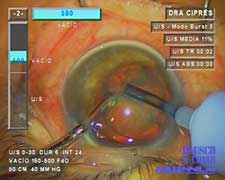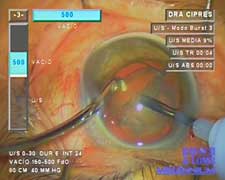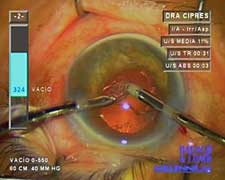Latest MICS platform decreases energy, power for safer surgery
One surgeon discusses her techniques to minimize adverse events such as corneal burns during surgery.
By combining personal technique with a microincision cataract surgery platform, one surgeon has been able to minimize the risk of corneal burns by decreasing the amount of power and energy required during surgery.
 Maria Cruz Ciprés |
Since 2005, Maria Cruz Ciprés, MD, has been analyzing her surgical outcomes using the Millennium MICS Platform software (Bausch & Lomb) to determine how they compare with conventional surgery. It has been specifically designed for use with the biaxial MICS technique.
Factors such as the size and shape of the incision, the tools used and the burst mode have all played a role in her success.
“Cataract surgery performed through microincisions using the fixed burst mode has the advantage of working with a closed chamber. That allows less decompression, better followability and reduced hydrodynamic trauma,” Dr. Ciprés said in an interview with Ocular Surgery News.
Study results
In a prospective study presented at the European Society of Cataract and Refractive Surgeons meeting in 2006, Dr. Ciprés compared 153 eyes operated with Bausch & Lomb’s Custom Control Software (CCS 2005) with multiple burst mode and 100 eyes operated with the new Millennium MICS Platform software with a fixed burst mode.
The CCS 2005 features a linear ultrasound power of 0% to 20%, a pulse length of 10 milliseconds and a pulse interval of 20 milliseconds. The new Millennium MICS Platform software upgrade has a linear ultrasound power ranging from 0% to 15%, a pulse length of 6 milliseconds and an interval of 24 milliseconds, according to Dr. Ciprés.
Mean patient age was 73 years in both groups, and the ratio of women to men was similar between the two groups.
The majority of cataracts were graded 3+, ranging from 1+ to 4+.
Patients were examined at 1, 7 and 30 days postoperatively.
According to Dr. Ciprés’ results, the mean power was significantly lower with the new Millennium MICS Platform software version group for all cataract grades. For grade 3 cataracts, the average phaco power was 5% in the CCS 2005 group and 3.6% in the new Millennium MICS Platform software version group.
Energy used by the Millennium MICS Platform software was 67% to 77% lower than the CCS 2005 group for all cataract grades. Mean energy required for grade 3 cataracts was 59 J in the CCS 2005 group and 9 J in the new Millennium MICS Platform software group. Mean energy required for grade 4 cataracts was 131 J in the CCS 2005 group and 37 J in the new Millennium MICS Platform software group.
Advantages of fixed burst
One of the key differences between the two techniques in Dr. Ciprés’ study was the type of burst mode used.
According to Dr. Ciprés, using a fixed burst mode allows the surgeon to choose between a range of minimum and maximum levels of power, whereas the ultrasound power is fixed in multiple burst mode.
Using MICS software in combination with the Millennium MICS Platform also allows the surgeon to increase the burst gradually, Dr. Ciprés said.
“Gradually ramping up the power achieves a ‘pulsed pulses’ effect. It is called waveform,” she said. “Followability improves, and there is more opportunity to occlude the phaco tip to achieve a vacuum holding force.”
 | Dr. Ciprés creates the capsulorrhexis with the cystotome. |
 |  |
| Dr. Ciprés notes that this view shows the strong holding force and a stable anterior chamber, even at 500 mm Hg of vacuum with good followability. | |
 | The final aspiration is easy, and the corneal incision at the end is clear, Dr. Ciprés said. The final parameters used can be seen in the top-right corner. Images: Ciprés MC |
Special surgical techniques
Dr. Ciprés’ surgical technique includes the creation of a 1.4-mm to 1.6-mm trapezoidal incision in the temporal clear cornea and another incision 160° to 180° from the first incision using a calibrated knife.
“I always prefer a trapezoidal clear cornea incision to perform MICS because it allows the movement of the surgical tools through the incision without producing wrinkles in the cornea,” she said.
She then creates a capsulorrhexis using a cystotome.
“I always use the cystotome to make the capsulorrhexis because I feel more sure and comfortable than with forceps,” she said.
Before performing hydrodissection and hydrodelineation of the cataract, it is important to remove the viscoelastic to prevent the nucleus from falling into the vitreous humor, she said.
“I utilize the hydrodelineation maneuver in order to create a concentric division plane between the hard inner endonucleus and the soft outer epinucleus,” she said.
For this maneuver, Dr. Ciprés uses a 19-gauge irrigating chopper with two ports measuring 0.8 mm.
“The flow is 0.82 cc, and the cut length is 0.95 mm. This gives me a desired flow pattern for efficient removal of nucleus particles, maintaining excellent anterior chamber stability, even at high vacuum settings,” she said.
This is followed by phacoemulsification using the 20-gauge StableFlow phaco needle.
According to Dr. Ciprés, the most difficult aspect of the procedure is properly inserting the MICS instruments in the eye.
In order to insert the irrigating chopper, Dr. Ciprés turns the tip horizontally and inserts it by using a clockwise motion. After it is inserted, she begins continuous anterior chamber infusion, she said.
The phaco needle should be inserted with the bevel down to prevent any damage to Descemet’s membrane and then rotated once inserted, she said.
Finally, Dr. Ciprés enlarges the corneal incision to 1.8 mm to accommodate the Akreos MI60 lens, part of the MICS Platform, specifically designed for MICS.
To shorten the learning curve required to adapt to the MICS platform, Dr. Ciprés says it is important to approach the surgery as though it were a traditional procedure.
“I believe the most important thing to achieve a short learning curve to perform bimanual MICS is to use the same surgery technique in coaxial phaco for bimanual MICS,” she said.
For more information:
- Maria Cruz Ciprés, MD, can be reached at Hospital San Rafael, Pg. Vall D’hebron, 107-117, 08023 Barcelona, Spain; +34-932-112-508; fax: +34-934-188-448; e-mail: mccipres@hsrafael.com. She has no financial interest in any of the products or companies mentioned in this article.
- Bausch & Lomb, maker of the Millennium MICS Platform, can be reached at www.bausch.com.
- Jared Schultz is an OSN Staff Writer who covers all aspects of ophthalmology. He focuses geographically on Europe and the Asia-Pacific region.
